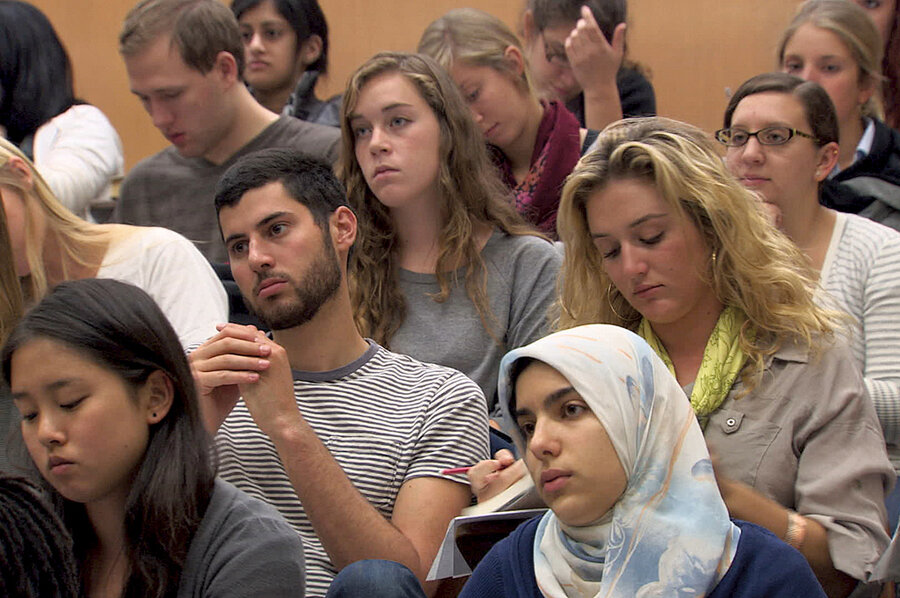'At Berkeley' opens the door to a kaleidoscopic learning lab
Loading...
In the fall of 2010, at a time of great debate, still ongoing, over tuition hikes and budget cuts, the great documentary filmmaker Frederick Wiseman and his cinematographer John Davey took their cameras to the University of California, Berkeley. The result, “At Berkeley,” is glorious – a four-hour meditation on the nature of education, especially publicly funded education, in the modern era.
In a larger sense, it’s about the opposition of idealism and hard reality at a time when the price of a college education, especially for the middle class, has become onerous. (The wealthy can afford it and the poor have subsidies, though not enough.) Since this is, after all, Berkeley, it’s not long into the movie before the question of privilege rears up. A female African-American student taking part in a sociology class discussion derides the woe-is-me elitism of middle-class whites concerned about poverty only when it hits home.
This woman, whose background was not privileged, is not exactly wrong to feel the way she does, but Wiseman is careful, as always, to avoid editorializing. One of the constants running through the film is that education, higher or lower, should not be a luxury for anybody.
Perhaps the most prestigious public university in America, Berkeley, at one time, offered free tuition to its students. Those days are long gone, although an extended student demonstration, complete with the requisite takeover of the campus library, has free tuition as one of its many demands. This is not, though many of the campus exhorters would wish it otherwise, the 1960s free-speech-movement era. Wiseman shows us the library occupiers as they attempt to revive the spirit of radical icons past, such as Mario Savio, but there’s a slight tinniness to the harangues. The occupiers, like that black student in the sociology class, are not wrong to feel the way they do, but in a recessionary era, calling for free tuition is a pie-in-the-sky gesture that inevitably ends up going nowhere. To the befuddled amazement of the administrators, including Berkeley’s chancellor, Robert Birgeneau, the sit-in rapidly disbands without incident.
A poignant undercurrent to the film is that not a few of the faculty and administrators at Berkeley came of age in the era of student radicalism and now find themselves, at least tactically, on the other side. Among his colleagues, Birgeneau speaks with some disdain of the demonstrators’ laundry list of grievances. The social movements that galvanized Birgeneau as a young man – the Vietnam War protests and civil rights marches – furnished a focus he doesn’t recognize in his present-day counterparts.
He may not be altogether aware that civil rights, even at Berkeley, is still a contentious issue. (If he sees this film, he will.) In an amazing scene, a black student, complaining of being shut out of study groups, offers to her nonblack classmates what she calls “the gift of honesty.” Her being shut out, it turns out, is by no means unrepresentative of her race.
Despite, or perhaps because of, all these disputations, Berkeley comes across as a great and ecumenical institution of learning – a far cry from how it has been pilloried by the far right. A biology instructor entreats her students to “find your own answers.” (In that spirit, Wiseman shows us what looks like campus ROTC training maneuvers, student vets discussing their fish-out-of-water experiences, and a few rah-rah football/marching band tableaux.) The range of classroom experience on view is absolutely exhilarating: artificial limb robotics; paleontology; neurobiology; a student performance of “Our Town”; dark energy astrophysics; the meaning, or meaninglessness, of time; poetry readings of e.e. cummings and John Donne; discussions of Thoreau on the combativeness and atrocities of the natural order; and much more. At times, watching “At Berkeley” is like being immersed in a kaleidoscopic learning lab – except, of course, it’s so much more than that.
Wiseman, as he has done in all his movies, is anatomizing an institution in the most direct and yet elusive of ways. Utilizing no narration, no titles, no archival footage or filmmaker interviews, he simply, intuitively, discovers the subject as he films it (and edits it – that’s where the real themes emerge from the great mass of footage). He has a novelistic grasp of story and character and a musical sense of how to rhythm it all together. “At Berkeley” builds its power in slow, sweeping accretions of scene and detail. Even the protracted administrative sessions, of which there are many, are necessary – boringness is part of the process, too. (The administrators are bored; we’re not.) One odd omission: Wiseman includes no scenes of dorm life. This may be the only movie ever made about college in which beer does not make an appearance.
The Berkeley we see in this film is both a singular institution and a microcosm. This is what must have attracted Wiseman. There is something immensely touching about the way the students are so roused by learning that we rarely hear them bemoan the dismal job market that awaits. A financial adviser tells one of the students, “Your education will never depreciate in value,” and the words do not ring hollowly. The fierce, questing intelligence of these students and educators is a perfect match for Wiseman’s own. Grade: A (Unrated.)





